The list of Roman hoards in Britain comprises significant archaeological hoards of coins, jewellery, precious and scrap metal objects and other valuable items discovered in Great Britain (England, Scotland and Wales) that are associated with period of Romano-British culture when Southern Britain was under the control of the Roman Empire, from AD 43 until about 410, as well as the subsequent Sub-Roman period up to the establishment of Anglo-Saxon kingdoms. It includes both hoards that were buried with the intention of retrieval at a later date (personal hoards, founder's hoards, merchant's hoards, and hoards of loot), and also hoards of votive offerings which were not intended to be recovered at a later date, but excludes grave goods and single items found in isolation.
Most Roman hoards are composed largely or entirely of coins, and are relatively common in Britain, with over 1,200 known examples.[1] A smaller number of hoards, such as the Mildenhall Treasure and the Hoxne Hoard, include items of silver or gold tableware such as dishes, bowls, jugs and spoons, or items of silver or gold jewellery.
List of hoards
| Hoard | Image | Date | Place of discovery | Year of discovery | Current location | Contents |
|---|---|---|---|---|---|---|
| Acton Hoard |  |
late 2nd century | Acton Cheshire 53°04′23″N 2°32′53″W / 53.073°N 2.548°W |
2014 | Nantwich Museum | Votive hoard of five silver denarii of the emperor Septimius Severus (AD 193–211) in a lead alloy conical container with a lead alloy disc stopper.[2] |
| Agden Hoard | late 3rd century | Woolstencroft Farm, Agden Cheshire 53°22′52″N 2°25′12″W / 53.381°N 2.420°W |
1957 | Grosvenor Museum, Chester | About 2,500 antoniniani and the lower half of jar[3] | |
| Aldbury Hoard | late 3rd century | near Aldbury Hertfordshire 51°48′29″N 0°35′38″W / 51.808°N 0.594°W |
1870 | 116 brass coins fragments of brass plate half a brass ring silver wire ring 2 brooches[4] | ||
| Alton Barnes Hoard | late 3rd century | Alton Barnes Wiltshire 51°21′32″N 1°50′46″W / 51.359°N 1.846°W |
2005 | Wiltshire Museum, Devizes | 3,854 silver and bronze Roman coins[5] | |
| Appleford Hoard | late 4th/early 5th century | Appleford-on-Thames Oxfordshire 51°38′18″N 1°15′10″W / 51.6382°N 1.2529°W |
1968 | Ashmolean Museum, Oxford | 24 pewter vessels, together with iron objects and tools[6] | |
| Appleshaw Hoard | 4th century | Appleshaw Hampshire 51°13′37″N 1°34′09″W / 51.227°N 1.5692°W |
1897 | British Museum, London | 32 pewter vessels, some marked with Christian symbols[7] | |
| Backworth Hoard | late 2nd century | Backworth Tyne and Wear 55°02′13″N 1°31′26″W / 55.037°N 1.524°W |
1811 | British Museum, London | Silver skillet covered by silver mirror, 5 gold rings, silver serpent ring, 2 gold chains with wheel and crescent pendants, silver-gilt brooches, 1 gold bracelet, silver spoons, 280 denarii, brass coins, silver dish[8] | |
| Baldock Hoard | 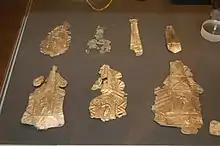 |
3rd to 4th century | near Baldock Hertfordshire 51°59′24″N 0°11′20″W / 51.990°N 0.189°W |
2002 | British Museum, London | 26 gold and silver objects including gold jewellery, 7 gold votive plaques, 12 silver votive plaques, two silver model arms, and a silver figurine[9] |
| Barkway Hoard |  |
early 3rd century | near Barkway Hertfordshire 52°00′14″N 0°00′04″E / 52.004°N 0.001°E |
1743 | British Museum, London | 5 silver and bronze objects, including one silver-gilt votive plaque dedicated to Mars, and two silver votive plaques dedicated to Vulcan[10] |
| Barlaston Hoard | 276 AD | Barlaston | 2015 | 2015 Roman coins and other objects [11] | ||
| Beau Street Hoard | second half of 3rd century | Bath Somerset 51°22′49″N 2°21′37″W / 51.3804°N 2.3604°W |
2008 | Roman Baths Museum, Bath | 30,000 silver Roman coins[12] | |
| Beckfoot Hoard | Unknown | Beckfoot, near Silloth Cumbria 54°49′12″N 3°24′36″W / 54.820°N 3.410°W |
2010 | 308 Roman coins in a pot[13] | ||
| Beech Bottom Dyke Hoard | early 2nd century | Beech Bottom Dyke, St Albans Hertfordshire 51°46′08″N 0°19′34″W / 51.769°N 0.326°W |
1932 | Dispersed | About 100 silver denarii[14] | |
| Binnington Carr Hoard | 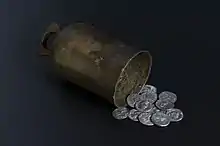 |
AD74-75 | Binnington Carr near Willerby, North Yorkshire 54°11′53″N 0°26′48″W / 54.1981°N 0.44659°W |
c. 1876 | Yorkshire Museum | 12 silver denarii[15] |
| Bishopswood Hoard | mid-4th century | Bishopswood, near Walford, Ross-on-Wye Herefordshire 51°52′12″N 2°35′06″W / 51.870°N 2.585°W |
1895 | Hereford Museum and Art Gallery | 17,548 coins[16] | |
| Blake Street Hoard | late-1st-century | York North Yorkshire 53°57′40″N 1°05′02″W / 53.961°N 1.084°W |
1975 | Yorkshire Museum British Museum |
35 silver denarii, the latest of Vespasian.[17] | |
| Boldre Hoard | late 3rd century | Boldre Hampshire 50°46′56″N 1°33′12″W / 50.7821°N 1.5533°W |
2014 | St Barbe Museum & Art Gallery, Lymington | 1,608 base silver radiates[18] | |
| Boothstown Hoard | late 3rd century | Boothstown Greater Manchester 53°30′07″N 2°25′12″W / 53.502°N 2.420°W |
1947 | British Museum, London Manchester Museum |
550 bronze coins dated between 259 and 278 AD found in two pottery urns[19] | |
| Boston Spa hoard | 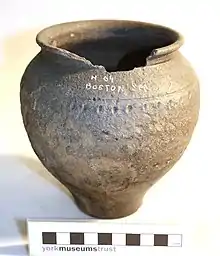 |
mid 2nd century | Boston Spa West Yorkshire 53°54′00″N 1°20′02″W / 53.900°N 1.334°W |
1848 | Yorkshire Museum | 172 silver denarii in a grey ware vessel |
| Bottesford hoard |  |
2nd century | Bottesford, Lincolnshire | – | North Lincolnshire Museum | 165 silver denarii and greyware vessel |
| Braithwell Hoard | late 3rd century | Braithwell South Yorkshire 53°26′38″N 1°12′11″W / 53.444°N 1.203°W |
2002 | British Museum (4) Doncaster Museum (1) |
1,331 base silver radiates 1 base metal denarius 13 sherds of greyware jar[20][21] | |
| Breamore hoards | late 3rd century | Breamore Hampshire 50°58′N 1°46′W / 50.96°N 1.77°W |
1998 (B) | Returned to finder (B) | Hoard A: 1,782 base silver radiates Hoard B:398 base silver radiates and pot[22] | |
| Bredon Hill Hoard |  |
mid-4th century | Bredon Hill Worcestershire 52°03′36″N 2°03′47″W / 52.060°N 2.063°W |
2011 | Worcestershire County Museum, Hartlebury Castle | 3,784 debased silver coins in a clay pot[23] |
| Burgh Castle Hoard | 3rd century | Burgh Castle Norfolk 52°34′57″N 1°39′05″E / 52.5826°N 1.6515°E |
1958–1961 | Glass vessels and a copper alloy bell placed in a bronze bowl, all within an iron-bound bucket.[24] | ||
| Canterbury Treasure | .JPG.webp) |
early 5th century | Canterbury Kent 51°16′41″N 1°05′38″E / 51.278°N 1.094°E |
1962 | Roman Museum, Canterbury | 12 silver spoons, 3 ingots, 1 tooth pick and jewellery[25] |
| Capheaton Treasure | 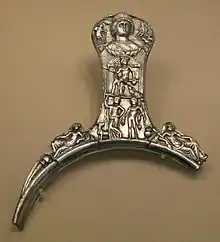 |
2nd or 3rd century | Capheaton Northumberland 55°07′26″N 1°56′49″W / 55.124°N 1.947°W |
1747 | British Museum, London | 5 silver vessel handles, and 1 fragment of a silver trulla base[26] |
| Castlethorpe Hoard | mid-2nd century | Castlethorpe Buckinghamshire 52°05′35″N 0°50′24″E / 52.093°N 0.840°E |
c. 1827 | British Museum, London | Coins, a pair of silver snakeshead bracelets (both inscribed undearneath), silver finger ring with carnelian intaglio. Found within a ceramic jar.[27][28] | |
| Chaddesley Corbett Hoard | early 4th century | Chaddesley Corbett Worcestershire 52°21′36″N 2°09′32″W / 52.360°N 2.159°W |
1999 and 2003 | Worcestershire County Museum, Hartlebury Castle | 434 base silver nummi 38 sherds of pottery[29][30] | |
| Chalgrove hoards |  |
late 3rd century | Chalgrove Oxfordshire 51°39′50″N 1°04′59″W / 51.664°N 1.083°W |
1989 (I) 2003 (II) |
Ashmolean Museum, Oxford (2003) | I: 4,145 coins ([31] II: 4,957 base silver coins[32] |
| Charnwood Forest Hoard | .jpg.webp) |
mid-3rd century | Mount St Bernard Abbey, Charnwood Forest Leicestershire 52°44′24″N 1°18′36″W / 52.740°N 1.310°W |
1840 | Large number of bronze coins, some dating between 254 and 268, in an urn[33] | |
| Chells Manor Hoard | late 3rd century | Chells Manor Estate, Stevenage Hertfordshire 51°55′05″N 0°09′36″W / 51.918°N 0.160°W |
1986 | 2,579 coins[34] | ||
| Chilbolton Down Hoard |  |
early 4th century | Chilbolton Down Hampshire 51°07′48″N 1°24′54″W / 51.130°N 1.415°W |
c. 1952 | Winchester City Museum | Bronze and silver coins dated 306–337 in a pot[35] |
| Chorleywood Hoard | mid-4th century | Chorleywood Hertfordshire 51°38′42″N 0°31′05″W / 51.645°N 0.518°W |
1977 | British Museum (244) Verulamium Museum, St Albans (446) |
4,358 coins[36] | |
| Clapton Hoard | late 3rd century | Clapton in Gordano Somerset 51°27′36″N 2°45′54″W / 51.460°N 2.765°W |
1922–1924 | Museum of Somerset, Taunton (59) and Nicholson Museum, Sydney, Australia (over 3400) | 3500 Roman bronze coins, (mainly Gallienus to Claudius II)[37] | |
| Cookley Hoard | mid 1st century | Cookley Suffolk 52°19′30″N 1°26′42″E / 52.325°N 1.445°E |
2018 | 58 silver denarii and two silver-plated fake denarii, dating between 153 BC and AD 61[38] | ||
| Corbridge Hoard (1911) |  |
150 | Corbridge Northumberland 54°58′41″N 2°01′59″W / 54.978°N 2.033°W |
1911 | British Museum | 160 gold aureus coins in a bronze jug, with two bronze coins in the neck of the jug to disguise the worth of contents. |
| Corbridge Hoard (1964) | 150 | Corbridge Northumberland 54°58′41″N 2°01′59″W / 54.978°N 2.033°W |
1964 | Corbridge Roman Site Museum Great North Museum, Newcastle upon Tyne |
Various finished and unfinished iron products, including pieces of armour, a sword scabbard, javelinheads, spearheads, arrowheads, artillery bolts, and various knives, nails, spikes and cramps[39] | |
| Corbridge Treasure |  |
300 | Corbridge Northumberland 54°58′16″N 2°00′58″W / 54.971°N 2.016°W |
1731–1760 | British Museum, London | 5 pieces of silverware, including a lanx[40] (serving platter), a bowl and a vase[41][42] |
| Cridling Stubbs Hoard (also known as Womersley I) | 346 | Cridling Stubbs North Yorkshire 53°40′59″N 1°12′47″W / 53.683°N 1.213°W |
1967 | Leeds City Museum (447 coins) | More than 3,300 bronze nummi coins in a grey-ware jar with a makeshift lid[43] | |
| Cunetio Hoard | 275 | Cunetio Roman town, Mildenhall Wiltshire 51°25′23″N 1°41′24″W / 51.423°N 1.690°W |
1978 | British Museum, London | 54,951 coins[44][45] | |
| Curridge Hoard | 209 | Curridge Berkshire 51°26′38″N 1°17′31″W / 51.444°N 1.292°W |
1998–1999 | West Berkshire Heritage | 425 bronze sestertius or dupondii/asses[46] | |
| Dairsie Hoard | 290 | Dairsie Fife 56°20′42″N 2°56′42″W / 56.345°N 2.945°W |
2014 | National Museum of Scotland, Edinburgh | More than 300 pieces of hacksilver from at least four silver Roman vessels[47] | |
| Deepdale Hoard | 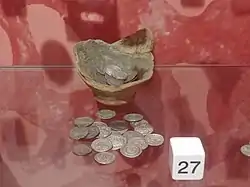 |
390 | Deepdale, Lincolnshire | 1979 | North Lincolnshire Museum | 260 silver siliquae[48] |
| Didcot Hoard |  |
late 2nd century | Didcot Oxfordshire 51°36′22″N 1°14′24″W / 51.606°N 1.240°W |
1995 | British Museum, London | 126 gold coins[1] |
| Drapers' Gardens Hoard | Late fourth or early fifth century | Drapers' Gardens, City of London | 2007 | Museum of London, London | 15 copper-alloy vessels, 3 lead/tin alloy vessels, 2 iron vessels, a broken copper-alloy bracelet, 2 nummi and an iron bucket binding, along with the remains of a juvenile deer. Found in a well.[49] | |
| Edge Hill Hoard | mid-1st century | Edge Hill Warwickshire 52°07′12″N 1°28′30″W / 52.120°N 1.475°W |
2008 | Market Hall Museum, Warwick | 1,146 silver denarii in a small pot, coins dating between 190 BC and AD 63–64[50] | |
| Ethy Hoard |  |
late 3rd century | Ethy, near Lerryn Cornwall 50°23′06″N 4°37′37″W / 50.385°N 4.627°W |
2000 | Royal Cornwall Museum, Truro | 1,095 base silver radiates coarseware jar[51] |
| Esclusham Hoard | late 1st century | Esclusham Wrexham 53°02′02″N 3°04′01″W / 53.034°N 3.067°W |
2016 | 82 silver denarii dating to the reigns of Augustus, Nero, Galba, Vitellius and Vespasian in a red pot[52] | ||
| Eye Hoard | late 4th century | Near Eye, Suffolk Suffolk 52°17′56″N 1°08′24″E / 52.299°N 1.140°E |
1781 | 600 gold coins[53] | ||
| Felmingham Hall Hoard | 2nd to 3rd centuries | near Felmingham Norfolk 52°48′53″N 1°20′23″E / 52.814648°N 1.339601°E |
1845 | British Museum, London | Romano-British temple treasure consisting of a pottery bowl, a buckle, a rattle, heads of Jupiter and Minerva, a mask of Sol with sun rays, a lar or household god, a wheel associated with the Celtic god Taranis, two statuettes of birds[54] | |
| Fenwick Hoard | 61AD | Colchester Essex [55] |
2014 | Colchester Castle[56] | 2 pairs of gold earrings, 1 gold bracelet, 2 gold armlets, 5 gold finger-rings, 1 silver chain and loop, 1 copper-alloy bulla, 1 silver armlet, 2 silver cuff bracelets, 1 glass intaglio, Roman republican coins, remains of a silver pyxis (jewellery box). | |
| Frampton Hoard | late 3rd century | Frampton Dorset 50°45′14″N 2°31′55″W / 50.754°N 2.532°W |
1998 | Returned to finder | 511 base silver radiates and pot[57] | |
| Fremington Hagg Hoard | 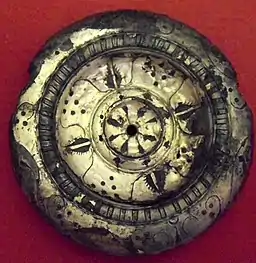 |
late 1st century | Fremington Hagg, Reeth North Yorkshire |
pre-1833 | British Museum and Yorkshire Museum | Several hundred pieces of horse-gear, including mounts and strap fittings.[58][59] |
| Frome Hoard | 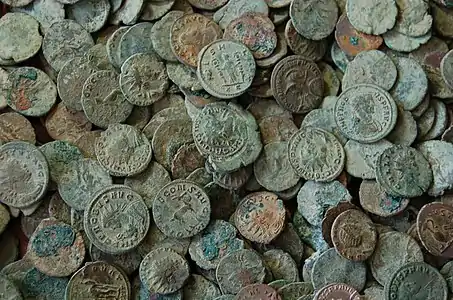 |
early 4th century | Near Frome Somerset 51°13′41″N 2°16′48″W / 51.228°N 2.280°W |
2010 | Museum of Somerset, Taunton | 52,503 coins (5 silver, the rest debased silver and bronze)[60] |
| Gloucester Hoard | early 1st century | Gloucester Gloucestershire 51°52′30″N 2°17′06″W / 51.875°N 2.285°W |
2017 | 8 silver denarii dated 134BC – AD37[61] | ||
| Grassmoor Hoard | 4th century | Grassmoor Derbyshire 53°12′04″N 1°23′49″W / 53.201°N 1.397°W |
2001 | Chesterfield Museum and British Museum, London | 1,421 silver coins[62] | |
| Hayle Hoard (1825) | late 3rd century | Hayle Cornwall 50°10′57″N 5°25′47″W / 50.1824°N 5.4297°W |
1825 | Royal Cornwall Museum, Truro | Several thousand radiates in a copper bowl[63] | |
| Hayle Hoard (2017) | late 3rd century | Hayle Cornwall 50°10′48″N 5°24′54″W / 50.180°N 5.415°W |
2017 | 1,965 base silver radiates with the remains of a tin container and a lead stopper, found in a stone-lined pit[64] | ||
| Heslington Hoard | 4th century | Heslington North Yorkshire 53°56′56″N 1°03′00″W / 53.949°N 1.050°W |
1966 | Yorkshire Museum | 2,800 coins[65] | |
| Hickleton Hoard | late 2nd century | Hickleton South Yorkshire 53°31′59″N 1°16′59″W / 53.533°N 1.283°W |
2001 | Doncaster Museum | 350 silver coins 36 copper-alloy coins[66] | |
| High Green Hoard | late 3rd century | High Green South Yorkshire 53°28′23″N 1°29′38″W / 53.473°N 1.494°W |
2001 | 738 base silver radiates[67] | ||
| High Weald Hoard | 3rd century | Burwash West Sussex |
2006 | Brighton Museum & Art Gallery | 2894 silver coins[68][69] | |
| Hockwold Hoard (1962) | 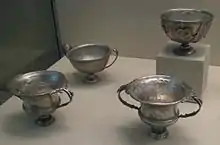 |
late 1st century | Hockwold cum Wilton Norfolk 52°27′54″N 0°32′31″E / 52.465°N 0.542°E |
1962 | British Museum, London | 4 silver cups 4 silver handles 1 silver pedestal[70] |
| Hockwold Hoard (1999) | mid-4th century | Hockwold cum Wilton Norfolk 52°27′54″N 0°32′31″E / 52.465°N 0.542°E |
1999 | British Museum, London | 816 copper alloy coins[71][72] | |
| Howe Hoard | late 1st century | Howe Norfolk 52°33′04″N 1°21′22″E / 52.551°N 1.356°E |
1981–2002 | British Museum, London | 15 gold aurei 131 silver denarii[73] | |
| Hoxne Hoard |  |
early 5th century | Hoxne Suffolk 52°19′48″N 1°10′59″E / 52.330°N 1.183°E |
1992 | British Museum, London | 14,865 coins (569 gold, 14,272 silver, 24 bronze) 29 items of gold jewellery 98 silver spoons and ladles 1 silver tigress 4 silver bowls 1 small dish 1 silver beaker 1 silver vase or juglet 4 pepper pots[74] |
| Huntingdon Muddy Hoard |  |
274 AD | Huntingdon, | 2018 | British Museum;
Norris Museum, St Ives, Cambridgeshire |
Pottery shards, (one pot in another)
9724 coins (3 silver denarii, several radiates and antonianianii)[75] |
| Hyderabad and Meeanee Barracks Hoard | 271 AD | Hyderabad and Meeanee Barracks, Colchester Essex 51°52′59″N 0°54′14″E / 51.883°N 0.904°E |
2011 | Colchester Museum | Two pots, one empty and one containing 1,247 coins[76][77] | |
| Ibberton Hoard | 333 AD | Ibberton | 2019 | British Museum;
rest dispersed in a March 2023 auction by Noonan's [78] |
393 nummi and fragments [79] | |
| Inchtuthil Hoard | .jpg.webp) |
late 1st century | Inchtuthil Perth and Kinross 56°32′28″N 3°25′26″E / 56.541°N 3.424°E |
1960 | Dispersed across various museums and private collections | 875,400 iron nails |
| Itteringham Hoard | late 2nd century | Itteringham Norfolk 52°49′52″N 1°10′59″E / 52.831°N 1.183°E |
2000 | British Museum, London | 3 silver finger rings 2 copper-alloy cosmetic sets 1 bronze key 62 silver denarii 42 copper-alloy coins pot fragments[80][81] | |
| Killingholme Hoard | first half of 4th century | South Killingholme Lincolnshire 53°36′00″N 0°16′30″W / 53.600°N 0.275°W |
1993 | Mostly dispersed; 86 in British Museum, London. | 3,800 bronze coins dating to reign of Constantine the Great in a pot[82] | |
| Kingston Deverill Hoard |  |
late 1st century | Kingston Deverill Wiltshire 51°07′59″N 2°13′12″W / 51.133°N 2.220°W |
2005 | Salisbury Museum | 3 bronze trullei or patera (shallow handled bowls) 2 bronze wine strainers[83] |
| Kirkham Hoard |  |
mid 3rd century | Kirkham Lancashire 53°46′55″N 2°52′23″W / 53.782°N 2.873°W |
1853 | Harris Museum, Preston, Lancashire | 35 silver denarii and one bronze semis in a Samian ware pot.[84][85] |
| Kirton in Lindsey hoards | 274 | Kirton in Lindsey Lincolnshire 53°28′34″N 0°35′20″W / 53.476°N 0.589°W |
1999 (1) 2001, 2004 (2) |
6 coins at British Museum, London | Hoard 1: 875 base silver radiates[86] Hoard 2: 111 base silver radiates (2001);[87] 85 base silver radiates (2004)[88] | |
| Knaresborough hoard |  |
300 | Knaresborough North Yorkshire |
1860 | Yorkshire Museum | Mixed metalwork. Copper alloy vessels: a large fluted bowl, six hemispherical 'Irchester' type bowls, four strainers with handles, a strainer bowl, a handled pan, two plates, a scale pan, and a large jar in the shape of a pottery vessel. Iron objects in the hoard include two iron axes, an adze, and a smith's cross. Objects accidentally melted down in the 19th century include several other large copper alloy plates, flat plates with handles, other dishes and bowls, a "great quantity" of iron nails, and a fire grate.[89] |
| Knutsford Hoard | .jpg.webp) |
late 2nd century | Knutsford Cheshire53°18′00″N 2°22′12″W / 53.300°N 2.370°W |
2012 | Liverpool Museum, Congleton Museum | 3 silver-gilt trumpet brooches, 2 silver finger rings, and more than 100 coins which were issued between 32BC to the late 2nd century AD[90] |
| Langley with Hardley Hoard | late 3rd century | Langley with Hardley Norfolk 52°33′43″N 1°29′06″E / 52.562°N 1.485°E |
1997, 1999, 2001, 2004 | Returned to finder | 2,044 base silver radiates[91][92][93][94] | |
| Langtoft hoards | early 4th century | Langtoft East Yorkshire 54°05′13″N 0°27′25″W / 54.087°N 0.457°W |
2000 | Yorkshire Museum, York British Museum, London |
Hoard A: 976 base silver coins and 21 sherds of a jar Hoard B: 924 base silver nummi and 9 sherds of a pot[95] | |
| Leominster Hoard (2013) | 290 | Leominster, Herefordshire 52°13′48″N 2°44′24″W / 52.230°N 2.740°W |
2013 | Returned to landowner | 518 Roman radiates, originally contained within leather bags.[96] | |
| Lightwood Hoard | 278 | Lightwood Road, Longton, Stoke-on-Trent Staffordshire 52°59′17″N 2°07′59″W / 52.988°N 2.133°W |
1960 | Potteries Museum & Art Gallery, Stoke-on-Trent | 2,461 coins and two silver bracelets in an earthenware pot[97] | |
| Malpas Hoard | 50 AD | Malpas, Cheshire | 2014 | Liverpool Museum, Congleton Museum | 7 Iron Age British coins made between AD20 and AD50. The 28 Roman coins are early examples, before the conquest of Britain, of the type that would have been in circulation when Roman soldiers arrived in Britain in AD43 [98] | |
| Little Brickhill hoards (1962–1964) | 4th century | Little Brickhill, Milton Keynes (borough) Buckinghamshire 51°59′46″N 0°42′36″W / 51.996°N 0.710°W |
1962–1964 | Bletchley Archaeological Society, Bletchley | 1962 251 loose coins About 400 corroded mass of coins 1964 4th-century pottery and sherds 13th-century jug (part) 11th to 12th-century sherds 2nd-century Samian ware fragments glass and jet beads 43 coins[99] | |
| Little Brickhill hoards (1967 & 1987) | late 2nd century | Little Brickhill, Milton Keynes (borough) Buckinghamshire 51°59′31″N 0°42′00″W / 51.992°N 0.700°W |
1967 1987 |
British Museum, London Buckinghamshire County Museum, Aylesbury |
1967 296 silver denarii hearth tools pottery bronze brooch and terret ring 3rd- to 4th-century sherds 1987 627 silver denarii[100] | |
| Little Orme Hoard (1981) | late 3rd or early 4th century | Little Orme, near Llandudno Conwy 53°19′26″N 3°46′41″W / 53.324°N 3.778°W |
1981 | National Museum Cardiff | 5 ox-head bucket-mounts 1 razor handle 1 knife or chisel handle 2 brooches 1 harness ring 68 coins[101] | |
| Llanvaches Hoard |  |
mid-2nd century | Llanvaches Monmouthshire 51°37′01″N 2°49′01″W / 51.617°N 2.817°W |
2006 | National Roman Legion Museum, Caerleon | 599 silver denarii[102] |
| M1 Motorway Hoard | late 3rd century | M1 motorway Leicestershire (see note) |
1980 (see note) | 207 silver denarii 228 base-silver radiates 2 grey ware pottery fragments[note 1][103] | ||
| Malmesbury Hoard | .jpg.webp) |
late 3rd century | Malmesbury Wiltshire |
2012 | Athelstan Museum, Malmesbury | 1266 coins (3 radiates, 1263 nummi) dating to the late 3rd-early 4th century AD within a ceramic vessel.[104] |
| Maundown Hoard | late 3rd century | Maundown, near Wiveliscombe Somerset 51°03′14″N 3°20′10″W / 51.054°N 3.336°W |
2006 | Museum of Somerset, Taunton | 2,118 bronze coins[105] | |
| Mildenhall Treasure |  |
mid-4th century | Mildenhall Suffolk 52°22′01″N 0°26′02″E / 52.367°N 0.434°E |
1942 | British Museum, London | 34 items of silver tableware[106] |
| Monknash Hoard | mid-2nd century | Monknash South Glamorgan 51°25′30″N 3°33′07″W / 51.425°N 3.552°W |
2000 | National Museum Wales, Cardiff | 103 silver denarii grey ware pot[107] | |
| Nether Compton Hoard | mid-4th century | Nether Compton Dorset 50°57′14″N 2°34′26″W / 50.954°N 2.574°W |
1989 | 22,670 coins[108] | ||
| Newport Pagnell Hoard | mid-4th century | near Newport Pagnell Buckinghamshire 52°05′13″N 0°43′19″W / 52.087°N 0.722°W |
2006 | More than 1,400 bronze coins pottery[109] | ||
| Osgodby Hoard | 2nd century | Osgodby Lincolnshire 53°25′01″N 0°22′59″W / 53.417°N 0.383°W |
1999 | British Museum, London | 44 silver denarii finger ring bronze brooch coarseware pottery vessel[110][111] | |
| Otterbourne Hoard I | 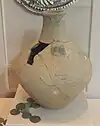 |
early 5th century | Otterbourne Hampshire 51°00′25″N 1°20′31″W / 51.007°N 1.342°W |
1978 | Winchester City Museum | Nearly 550 silver siliquae and other coins dated 364–423 in a pot[112] |
| Otterbourne Hoard II |  |
early 5th century | Otterbourne Hampshire 51°00′25″N 1°20′31″W / 51.007°N 1.342°W |
1978 | Winchester City Museum | Silver siliquae[112] |
| Overton Hoard | .jpg.webp) |
205 AD | Overton North Yorkshire 53°59′38″N 1°09′22″W / 53.994°N 1.156°W |
2016 | Yorkshire Museum, York | 37 silver coins and pottery fragments.[113] |
| Patching Hoard | mid-5th century | Patching West Sussex 50°50′49″N 0°27′25″W / 50.847°N 0.457°W |
1997 | Worthing Museum and Art Gallery | 13 Roman and 10 Visigothic gold solidi 21 Roman, 3 Visigothic, and 3 unidentified silver coins 2 gold rings 54 pieces of scrap silver, including a scabbard fitting[114] | |
| Piddletrenthide Hoard |  |
late 3rd century | Piddletrenthide, Dorset 50°48′00″N 2°25′30″W / 50.800°N 2.425°W |
2016 | 2,114 Roman radiate coins in an incomplete pottery vessel.[115] | |
| Pot Shaft Hoard | 4th century | Alderley Edge Mines Cheshire 53°17′46″N 2°12′43″W / 53.296°N 2.212°W |
1995 | Manchester Museum | 564 Roman coins dating from AD 317–336, mainly Constantine and house of Constantine pieces[116] | |
| Preshaw Park Hoard | 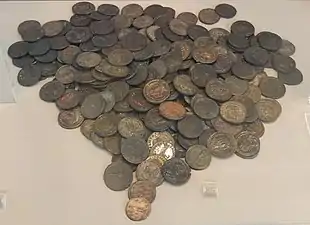 |
early 4th century | Preshaw Park, Exton Hampshire 51°00′58″N 1°11′17″W / 51.016°N 1.188°W |
1855 | Winchester City Museum | 280 uncirculated bronze coins dated 280–309 in a narrow-necked pot[117] |
| Prestwood hoards | early 3rd to early 4th century | Prestwood Buckinghamshire 51°41′35″N 0°43′55″W / 51.693°N 0.732°W |
1999 and 2005 | Buckinghamshire County Museum, Aylesbury | Hoard A: 112 silver denarii and 1 radiate Hoard B: 735 base silver nummi and pot fragment[118][119] | |
| Reading Hoard | Unknown | The Ridgeway School, Reading Berkshire 51°25′41″N 0°57′07″W / 51.428°N 0.952°W |
2015 | Reading Museum, Reading | About 300 coins in a pottery vessel[120][121] | |
| Rhayader Treasure | 2nd to 3rd century | Rhayader Powys 52°17′N 3°30′W / 52.29°N 3.50°W |
1899 | British Museum, London | 1 gold ring with onyx stone; 11 pieces of gold necklet with 8 stones, 1 piece of scroll and a small embossed section; 4 pieces of gold armlet[122] | |
| Ribchester Hoard | 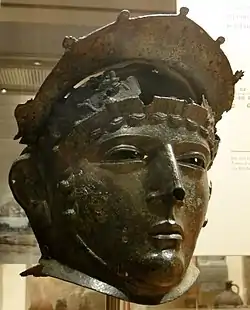 |
late 1st to early 2nd century | Ribchester Lancashire 53°49′N 2°32′W / 53.81°N 2.53°W |
1796 | British Museum, London | A bronze cavalry helmet, a number of patera, pieces of a vase, a bust of Minerva, fragments of two basins, and several plates.[123] |
| Rogiet Hoard | late 3rd century | Rogiet Monmouthshire 51°35′N 2°47′W / 51.58°N 2.79°W |
1998 | National Museum of Wales, Cardiff | 3,778 silver coins[124] | |
| Ryedale Hoard | .jpg.webp) |
late 2nd century | Ryedale North Yorkshire |
2020 | Yorkshire Museum, York | Four copper alloy objects: A bust of Marcus Aurelius (probably from a sceptre), a horse-and-rider figurine, a zoomorphic key handle, and a plumb bob.[125] |
| Seaton Down Hoard | _(FindID_635371).jpg.webp) |
early 4th century | Seaton Down Devon |
2013 | Royal Albert Memorial Museum, Exeter | 22,888 copper alloy coins[126][127] |
| Sarum Road Hoard |  |
early 1st century | Sarum Road, Winchester Hampshire 51°03′36″N 1°21′54″W / 51.060°N 1.365°W |
1996 | Winchester City Museum | 8 silver denarii dated 78BC – AD37[128] |
| Shapwick hoards (1936–1938) | early 4th to mid-5th century | Shapwick Somerset 51°08′N 2°50′W / 51.14°N 2.83°W |
1936–1938 | Museum of Somerset, Taunton British Museum, London |
Pewter cup, saucer, platter, jug, canister, bowl with pedestal pottery beaker 245 silver siliquae 1,170 bronze coins bronze cased wooden stave tankard bronze bowl[129] | |
| Shapwick Hoard (1978) | 4th century | Shapwick Somerset 51°08′N 2°50′W / 51.14°N 2.83°W |
1978 | Glastonbury Museum | More than 1,000 copper coins pewter vessel[130] | |
| Shapwick Hoard (1998) | mid-3rd century | Shapwick Somerset 51°08′N 2°50′W / 51.14°N 2.83°W |
1998 | Somerset County Museum, Taunton | 9,262 coins[131][132] | |
| Shillington Hoard | late 1st century | Shillington Bedfordshire 51°58′12″N 0°21′47″W / 51.970°N 0.363°W |
1998–1999 | Wardown Park Museum, Luton | Hoard A: 127 gold aurei Hoard B: 18 silver denarii[133] | |
| Shiptonthorpe Hoard | early 4th century | Shiptonthorpe East Yorkshire 53°52′44″N 0°42′18″W / 53.879°N 0.705°W |
2000 | Hull and East Riding Museum, Kingston upon Hull | 503 base silver coins pot fragments[134] | |
| Shoreham Hoard | late 3rd century | Shoreham-by-Sea West Sussex 50°49′59″N 0°16′05″W / 50.833°N 0.268°W |
1999 | 4,105 base silver denarii and radiates pottery vessel[86] | ||
| Shrewsbury Hoard | .jpg.webp) |
mid-4th century | near Shrewsbury Shropshire 52°43′N 2°45′W / 52.71°N 2.75°W |
2009 | Shrewsbury Museum and Art Gallery | 9,315 bronze coins[135] |
| Silchester Hoard (1894) | .jpg.webp) |
late 2nd century | Silchester Hampshire 51°21′N 1°05′W / 51.35°N 1.09°W |
1894 | Reading Museum British Museum, London |
258 silver denarii[136] |
| Silchester Hoard (1985–1987) | early 5th century | Silchester Hampshire 51°21′N 1°05′W / 51.35°N 1.09°W |
1985–1987 | Reading Museum | About 39 silver and bronze coins 3 gold rings[137] | |
| Snettisham Jeweller's Hoard | 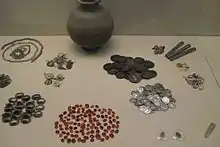 |
mid-2nd century | Snettisham Norfolk 52°52′34″N 0°29′49″E / 52.876°N 0.497°E |
1985 | British Museum, London | 83 silver coins, 27 bronze coins, and quantities of gems, jewellery and scrap metal[138] |
| Snodland Hoard |  |
mid-4th century | Snodland Kent 51°19′41″N 0°26′49″E / 51.328°N 0.447°E |
2006 | More than 3,600 bronze coins[139] | |
| South Petherton Hoard | 274 AD | South Petherton | 2013 | Sestertius of Marcus Aurelius in Museum of Somerset, majority returned to the finder | 7,563 coins dating from 161 to 274 AD mainly debased Antoninianii of the Gallic Empire [140] | |
| St Albans Hoard | late 4th century | St Albans Hertfordshire |
2012 | Verulamium Museum, St Albans | 159 gold solidi[141] | |
| Stanchester Hoard | early 5th century | Wilcot Wiltshire 51°21′N 1°47′W / 51.35°N 1.79°W |
2000 | Wiltshire Museum, Devizes | 1,166 coins (3 gold, 1,162 silver, 1 bronze)[142] | |
| Stogursey Hoard (1999) | late 3rd century | Stogursey Somerset 51°11′N 3°08′W / 51.18°N 3.14°W |
1999 and 2002 | 3 coins at British Museum some others at Somerset |
1,097 base silver radiates pottery vessel remains[91][note 2] 50 copper alloy coins[144] | |
| Stoke-on-Trent Hoard A | late 2nd century | Stoke-on-Trent Staffordshire 53°00′N 2°12′W / 53.0°N 2.2°W |
2012 | Potteries Museum & Art Gallery, Hanley | 258 silver denarii dating between 31 BC and AD 176[145] | |
| Stony Stratford Hoard | 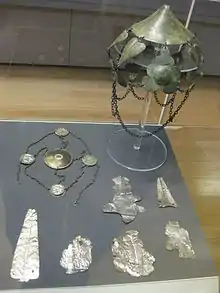 |
3rd century | Old Stratford Northamptonshire 52°03′22″N 0°51′54″W / 52.056°N 0.865°W |
1789 | British Museum, London | 2 chain headresses, 3 fibulae, various fragments of silver plaques with figures of, or inscriptions to, Roman gods, in an urn[146] |
| Sully Hoard (1899) | late 3rd century | Sully, Vale of Glamorgan South Glamorgan 51°25′N 3°13′W / 51.41°N 3.21°W |
1899 | British Museum, London | 322 coins (7 gold, some silver, and rest bronze) 4 gold rings[147][148] | |
| Sully Hoard (2008) | .jpg.webp) |
mid-4th century | Sully, Vale of Glamorgan South Glamorgan 51°25′N 3°13′W / 51.41°N 3.21°W |
2008 | National Museum Wales | 2,366 bronze coins in one pot 3,547 bronze coins in another pot[149] |
| Thetford Hoard | mid-4th century | near Thetford Norfolk 52°25′N 0°44′E / 52.41°N 0.74°E |
1979 | British Museum, London | 33 silver spoons 22 gold finger rings 4 pendants several necklaces a gold buckle[150] | |
| Thornbury Hoard | 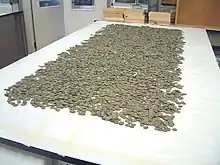 |
mid-4th century | Thornbury Gloucestershire 51°36′32″N 2°31′12″W / 51.609°N 2.520°W |
2004 | Bristol City Museum and Art Gallery |
11,460 coins[151] |
| Tinwell Hoard | late 3rd century | Tinwell Rutland 52°39′43″N 0°31′59″W / 52.662°N 0.533°W |
1999 | Rutland County Museum, Oakham | 2,831 base-silver coins[152] | |
| Traprain Treasure |  |
early 5th century | Traprain Law, near Haddington East Lothian 55°57′36″N 2°40′26″W / 55.960°N 2.674°W |
1919 | Museum of Scotland, Edinburgh | 53 pounds of sliced up silver tableware some Christian items a Roman officer's uniform 4 coins[153] |
| Upchurch Hoard | 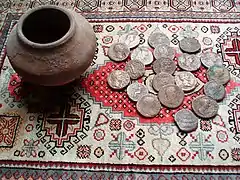 |
early 4th century | Upchurch Kent 51°23′06″N 0°39′47″E / 51.385°N 0.663°E |
1950 | Private collection | 37 bronze coins[154] |
| Vale of Pewsey hoard (2020) | 340 – 402 | Vale of Pewsey Wiltshire |
2020 | 160 silver coins and 1 copper coin[155] | ||
| Walton (Milton Keynes) Hoard | early 4th century | Walton, Milton Keynes Buckinghamshire 52°01′12″N 0°42′43″W / 52.020°N 0.712°W |
1987 | 97 bronze coins[156] | ||
| Water Newton Treasure |  |
4th century | Water Newton Cambridgeshire 52°33′N 0°20′W / 52.55°N 0.34°W |
1975 | British Museum, London | 27 silver items, including jugs, hanging-bowls, bowls and votive plaques 1 gold votive plaque[157] |
| Welbourn Hoard | mid-4th century | Welbourn Lincolnshire 53°04′N 0°33′W / 53.06°N 0.55°W |
1998 | 8 coins at British Museum, London | 436 base silver nummi Shelly Ware container[158] | |
| Wem Hoard | late 5th century | Wem Shropshire 52°51′00″N 2°45′00″W / 52.85°N 2.750°W |
2018 | 336 items of Roman hacksilver, including 37 Roman coins[159][160] | ||
| West Bagborough Hoard | mid-4th century | West Bagborough Somerset 51°05′N 3°11′W / 51.09°N 3.18°W |
2001 | Somerset County Museum, Taunton | 669 Roman coins and 64 pieces of hacksilver[161] | |
| Westhall Hoard | mid-2nd century[note 3] | Westhall Suffolk 52°24′36″N 1°32′46″E / 52.410°N 1.546°E |
1855 | British Museum, London Norwich Castle Museum |
9 bronze terrets and some Roman coins in a bronze bowl[162][163] | |
| Weston Underwood Hoard | 1st and 2nd century | Weston Underwood, Milton Keynes (borough) Buckinghamshire 52°09′36″N 0°45′18″W / 52.160°N 0.755°W |
1858 | Buckinghamshire County Museum | 166 silver denarii 10 other coins earthenware vessel Samian bowl various sherds and other pottery[164] | |
| Wickham Market Hoard | late 3rd century | Wickham Market Suffolk 52°09′29″N 1°21′47″E / 52.158°N 1.363°E |
1984 | Pot containing 1,587 coins[165] | ||
| Wold Newton Hoard |  |
307 AD | Wold Newton East Yorkshire 54°08′24″N 0°24′00″W / 54.140°N 0.400°W |
2014 | Yorkshire Museum, York | 1,857 copper coins in ceramic pot[166] |
| Womersley II | 354 AD | Wold Newton East Yorkshire 53°41′26″N 1°13′16″W / 53.6906°N 1.22106°W |
2011 | Wakefield Museum | 445 nummi in and associated metalwork.[167] Note that the Cridling Stubbs Hoard is also known as Womersley I | |
| Yeovil Hoard | 270 AD | Yeovil Somerset |
2013 | Museum of Somerset | 3335 coins, including 165 denarii, originally contained in a cloth bags[168] | |
| York Hoard (1840) | 3rd century AD | York North Yorkshire |
1840 | Yorkshire Museum | Approximately 200 denarii.[169] | |
| Yorkley Hoard | mid-4th century | Yorkley Gloucestershire 51°45′36″N 2°31′48″W / 51.760°N 2.530°W |
2012 | Dean Heritage Centre, Gloucestershire | 500 bronze coins, probably originally contained in a cloth bag[170] |
See also
Notes
- ↑ The hoard was reported by a widow whose husband had been a digger driver working on the motorway. The exact location and date of the find was not known.
- ↑ There was also a Bronze Age gold ornament found at the same time, but it is not considered to be part of this hoard.[143]
- ↑ The Roman coins in the Westhall Hoard indicate a burial later than 138 AD, but the terrets date to the Iron Age, circa 1–70 AD, probably before the Roman Conquest.
Footnotes
- 1 2 "Didcot hoard". British Museum. Retrieved 14 July 2010.
- ↑ Oakden, Vanessa (2015). 50 Finds From Cheshire: Objects from the Portable Antiquities Scheme. Amberley Publishing Limited. ISBN 9781445646916.
- ↑ Historic England. "Monument No. 74881". Research records (formerly PastScape). Retrieved 6 August 2010.
- ↑ Historic England. "Monument No. 346418". Research records (formerly PastScape). Retrieved 6 August 2010.
- ↑ "Roman coin hoard goes on display". Wiltshire Museum. 22 July 2009. Retrieved 4 October 2010.
- ↑ Historic England. "Monument No. 238370". Research records (formerly PastScape). Retrieved 7 August 2010.
- ↑ Historic England. "Monument No. 228060". Research records (formerly PastScape). Retrieved 7 August 2010.
- ↑ Historic England. "Monument No. 26672". Research records (formerly PastScape). Retrieved 7 August 2010.
- ↑ Gannon, Voden-Decker & Bland 2004a, pp. 38–44
- ↑ Walters & Smith 1921, p. 59
- ↑ "Coin Hoard WMID-225242". Portable Antiquities Scheme. 28 April 2016. Retrieved 9 April 2017.
- ↑ "Hoard of Roman coins found near Roman Baths in Bath". BBC News. 22 March 2012. Retrieved 22 March 2012.
- ↑ Jorsh, Mag; Clarke, Andrew (10 January 2011). "Cumbrian man unearths Roman treasures in field near Silloth". News and Star. Archived from the original on 4 September 2012. Retrieved 15 October 2011.
- ↑ Historic England. "Monument No. 361921". Research records (formerly PastScape). Retrieved 2 August 2010.
- ↑ Historic England. "Monument No. 64828". Research records (formerly PastScape). Retrieved 20 September 2019.
- ↑ "Herefordshire Through Time". Herefordshire Council. Archived from the original on 9 June 2011. Retrieved 17 July 2010.
- ↑ Thorp, F. (1976). "The Yorkshire Archaeological Register 1975". Yorkshire Archaeological Journal. 48: 5.
- ↑ "Roman Boldre Hoard goes on display at St Barbe Museum". BBC News. 30 July 2017. Retrieved 11 August 2017.
- ↑ Historic England. "Monument No. 44272". Research records (formerly PastScape). Retrieved 14 July 2010.
- ↑ Gannon, Voden-Decker & Bland 2004a, pp. 132–133, 145
- ↑ Barton & Hitchcock 2008, p. 199
- ↑ Bland 2000, p. 121
- ↑ Henry, Richard (21 October 2011). "The Bredon Hill Hoard: The process from discovery to present". Portable Antiquities Scheme. Archived from the original on 23 October 2011. Retrieved 21 October 2011.
- ↑ Johnson, S. (1983). Burgh Castle: Excavations by Charles Green 1958–61. Gressenhall. p. 79.
- ↑ "Replica in the British Museum". British Museum. Retrieved 25 July 2010.
- ↑ "Silver handle from the Capheaton treasure". British Museum. Archived from the original on 16 December 2010. Retrieved 25 July 2010.
- ↑ "Collections online. Bracelet. AF.413.a". British Museum. Retrieved 10 May 2019.
- ↑ Cool, H. E. M. (1979). "A Newly Found Inscription on a Pair of Silver Bracelets from Castlethorpe, Buckinghamshire". Britannia. 10: 165–168. doi:10.2307/526052. JSTOR 526052. S2CID 162128754.
- ↑ Bland 2000, p. 123
- ↑ Gannon, Voden-Decker & Bland 2004b, pp. 160, 183
- ↑ Historic England. "Monument No. 1302805". Research records (formerly PastScape). Retrieved 10 August 2010.
- ↑ Gannon, Voden-Decker & Bland 2004b, p. 159
- ↑ Pettigrew, T. J. (April 1851). "On a Roman urn found in Charnwood Forest". Journal of the British Archaeological Association. 7: 1–5. doi:10.1080/00681288.1851.11886949.
- ↑ Historic England. "Monument No. 1256324". Research records (formerly PastScape). Retrieved 6 August 2010.
- ↑ "Untitled". Proceedings of the Hampshire Field Club and Archaeological Society. XVIII: 322. 1952.
- ↑ Historic England. "Monument No. 395271". Research records (formerly PastScape). Retrieved 8 August 2010.
- ↑ Historic England. "Monument No. 195361". Research records (formerly PastScape). Retrieved 2 January 2012.
- ↑ "Roman coin stash 'may have been linked to Boudiccan revolt'". BBC News. 15 July 2019. Retrieved 15 July 2019.
- ↑ Buchwald, Vagn Fabritius (2005). Iron and steel in Ancient Times. Kgl. Danske Videnskabernes Selskab. p. 285. ISBN 978-87-7304-308-0.
- ↑ Historic England. "Monument No. 18463". Research records (formerly PastScape). Retrieved 10 August 2010.
- ↑ "The Corbridge Lanx". British Museum. Retrieved 29 July 2010.
- ↑ Historic England. "Monument No. 18543". Research records (formerly PastScape). Retrieved 10 August 2010.
- ↑ Pirie, Elizabeth (1958). "A Constantinian Coin Hoard from Womersley, W.R". The Yorkshire Archaeological Journal. 42 (2): 127–129.
- ↑ Abdy 2002, pp. 41–44
- ↑ British Museum Collection
- ↑ Bland 2000, pp. 113–114
- ↑ "'Significant' Roman silver hoard found in Fife by teenager". BBC News. 1 August 2017. Retrieved 1 August 2017.
- ↑ Iron Age and Roman Coin Hoards in Britain. Oxbow Books. 2020. p. 175. ISBN 9781785708589. Retrieved 15 July 2022.
- ↑ Gerrard, James (2009). "The Drapers' Gardens Hoard: a preliminary account". Britannia. 40: 163–183. doi:10.3815/006811309789786052.
- ↑ "Roman silver coins go on display in Warwick". BBC News. 6 July 2011. Retrieved 6 July 2011.
- ↑ Bland & Voden-Decker 2002, pp. 117–118, 133
- ↑ Sheehan, Rory (20 December 2017). "Treasures trove finds in both Flintshire and Wrexham". Retrieved 14 January 2018.
- ↑ Johns, Catherine & Bland, Roger (1994). "The Hoxne Late Roman Treasure". Britannia. 25: 165–173. doi:10.2307/526995. ISSN 1753-5352. JSTOR 526995. OCLC 51206459. S2CID 162359266.
- ↑ British Museum Collection
- ↑ Crummy, Philip (15 July 2014). "Colchester: death by sword in Boudicca's war?". The Colchester Archaeologist. Retrieved 9 April 2017.
- ↑ "Fenwick Hoard – On display at Colchester Castle". Colchester + Ipswich Museums. Colchester & Ipswich Museums. 2016. Retrieved 4 August 2016.
- ↑ Bland 2000, p. 120
- ↑ Historic England. "Monument No. 48764". Research records (formerly PastScape).
- ↑ P. T. Craddock; Janet Lang; K. S. Painter (1973). "Roman Horse-Trappings from Fremington Hagg, Reeth, Yorkshire, N.R". British Museum Quarterly. 37 (1/2): 9–17. doi:10.2307/4423122. JSTOR 4423122.
- ↑ "The Frome Hoard". Portable Antiquities Scheme. Archived from the original on 12 July 2010. Retrieved 14 July 2010.
- ↑ Jenkins, Robin (10 January 2018). "Hoard of 2,000-year-old coins found in field is "very rare indeed"". Retrieved 12 January 2018.
- ↑ Bland & Voden-Decker 2003, pp. 97, 105
- ↑ "The Hayle Hoard of Radiate Minimi". The Numismatic Chronicle and Journal of the Royal Numismatic Society: 203–208. 1936.
- ↑ Wilkinson, Graeme (23 August 2017). "Treasure hunting pair unearthed nearly 2000 Roman coins in a field in Cornwall". Retrieved 23 August 2017.
- ↑ Carson, R. A. G.; Kent, J. P. C. (1971). "A Hoard of Roman Fourth-Century Bronze Coins from Heslington, Yorkshire". The Numismatic Chronicle. 11: 207–225.
- ↑ Bland & Voden-Decker 2003, pp. 94–95, 105
- ↑ Bland & Voden-Decker 2003, pp. 95, 105
- ↑ "High Weald hoard of Roman coins on display in Sussex". 15 March 2012. Retrieved 16 March 2012.
- ↑ Coin Hoards and Hoarding in Britain (3): Radiate Hoards table. https://www.academia.edu/11467882/Coin_Hoards_and_Hoarding_in_Britain_3_Radiate_Hoards_table
- ↑ "Hoard of silver drinking cups". British Museum. Archived from the original on 16 November 2010. Retrieved 14 July 2010.
- ↑ Bland 2000, pp. 123–124
- ↑ Bland & Voden-Decker 2002, pp. 121, 134
- ↑ Gannon, Voden-Decker & Bland 2004b, p. 153
- ↑ "The Hoxne hoard". British Museum. Archived from the original on 29 April 2011. Retrieved 14 July 2010.
- ↑ Museum, The British; Street, Great Russell; T: +4420 73238618, London WC1B 3DG. "Record ID: CAM-A0ECFB - ROMAN hoard". The Portable Antiquities Scheme. Retrieved 22 September 2023.
{{cite web}}: CS1 maint: numeric names: authors list (link) - ↑ "Coin Hoard ESS-F89194". Portable Antiquities Scheme. 8 June 2011. Retrieved 9 April 2017.
- ↑ Crummy, Philip (22 November 2013). "'In the days before banks' (about a Roman Colchester coin hoard) from "the Colchester Archaeologist" magazine no 24 in 2011". The Colchester Archaeologist. Retrieved 9 April 2017.
- ↑ "Ancient Coins and Antiquities (8 & 9 March 2023): Lot 767 | Noonans Mayfair". www.noonans.co.uk. Retrieved 28 February 2023.
- ↑ Museum, The British; Street, Great Russell; T: +4420 73238618, London WC1B 3DG. "Record ID: DOR-B2AD83 - ROMAN coin hoard". The Portable Antiquities Scheme. Retrieved 28 February 2023.
{{cite web}}: CS1 maint: numeric names: authors list (link) - ↑ Bland & Voden-Decker 2002, pp. 24–25, 113, 133
- ↑ British Museum Collection
- ↑ "Killingholme". Retrieved 31 December 2017.
- ↑ "Kingston Deverill Hoard". The Salisbury Museum. Retrieved 11 March 2023.
- ↑ "Harris Museum & Art Gallery: Collections: Coins and Medals". Harris Museum. Retrieved 8 May 2017.
- ↑ Howard-Davis, Christine; Buxton, Kath (2000). Roman forts in the Fylde: excavations at Dowbridge, Kirkham. Centre for North West Regional Studies, Lancaster University. p. 56. ISBN 9781862200869.
- 1 2 Bland 2000, p. 118
- ↑ Bland & Voden-Decker 2003, pp. 95–96
- ↑ Hitchcock 2006, p. 179
- ↑ "Oct 3rd The Rev Canon Raine read the following paper – "The Roman Bronze Vessels Founds near Knaresboro". Annual Report of the Yorkshire Philosophical Society: 16–19. 1876.
- ↑ "The Knutsford Hoard". National Museums Liverpool. Retrieved 9 April 2017.
- 1 2 Bland 2000, p. 119
- ↑ Bland & Voden-Decker 2002, p. 118
- ↑ Bland & Voden-Decker 2003, p. 96
- ↑ Barton & Hitchcock 2008, p. 198
- ↑ Bland & Voden-Decker 2002, pp. 118–120, 133
- ↑ "HESH-91B963 – Coin Hoard". Portable Antiquities Scheme. 20 April 2017. Retrieved 6 December 2017.
- ↑ "The Lightwood Hoard". Stoke-on-Trent Museums. Archived from the original on 11 September 2012. Retrieved 18 October 2010.
- ↑ "The Malpas Hoard". National Museums Liverpool. Retrieved 9 April 2017.
- ↑ Historic England. "Monument No. 344783". Research records (formerly PastScape). Retrieved 26 July 2010.
- ↑ Historic England. "Monument No. 344788". Research records (formerly PastScape). Retrieved 26 July 2010.
- ↑ "Little Orme hoard, Llandudno (Roman)". Archived from the original on 9 July 2012. Retrieved 6 August 2010.
- ↑ "The Llanvaches Roman coin hoard". National Museum Wales. 15 July 2011. Retrieved 12 November 2020.
- ↑ Bland & Voden-Decker 2002, pp. 116–117
- ↑ "Malmesbury Roman coin hoard set to go on display". BBC News. 3 April 2022. Retrieved 22 March 2023.
- ↑ "Bronze coins found in Somerset reveal Roman age of austerity". Western Daily Press. 7 December 2011. Archived from the original on 14 September 2012. Retrieved 7 December 2011.
- ↑ "The Mildenhall treasure". British Museum. Archived from the original on 27 July 2010. Retrieved 14 July 2010.
- ↑ Bland & Voden-Decker 2002, pp. 113, 133
- ↑ "Nether Compton Hoard". Forum Ancient Coins. Retrieved 17 July 2010.
- ↑ Hannam, Laura (29 October 2008). "Treasure hunters set to coin it with Roman haul". MK News. Archived from the original on 6 September 2012. Retrieved 24 July 2010.
- ↑ Bland 2000, p. 112
- ↑ British Museum Collection
- 1 2 "Untitled". British Archaeological Abstracts. 22: 296. 1989.
- ↑ Tilley, E. "THE OVERTON HOARD: A SEVERAN HOARD FROM NORTH YORKSHIRE". York Museums Trust. Retrieved 2 July 2019.
- ↑ White, Sally (1998). "The Patching Hoard" (PDF). Medieval Archaeology. 42: 88–93. doi:10.1080/00766097.1998.11735619.
- ↑ "Detectorists strike gold as British Museum reveals record haul". The Guardian. 4 December 2017. Retrieved 6 December 2017.
- ↑ Anon (December 1996). The 'Pot Shaft' Hoard, Alderley Edge, Cheshire. Coins in Context: the controlled micro-excavation of a fourth-century Roman coin hoard. Final Report. University of Manchester Archaeological Unit.
- ↑ "Letters: The importance of local sales". The Archeological News Letter: xliii. 1948.
- ↑ Bland 2000, pp. 115, 123
- ↑ Barton & Hitchcock 2008, p. 193
- ↑ "Roman coin hoard unearthed at Reading primary school". BBC News. Retrieved 16 May 2015.
- ↑ "Roman Coins Discovered Buried at The Ridgeway Primary School". Reading Borough Council. 11 May 2015. Retrieved 16 May 2015.
- ↑ "The Treasure of Vortigern". Vortigern Studies. Retrieved 7 August 2010.
- ↑ Baines, Edward; Whatton, W. R. (1836). History of the County Palatine and Duchy of Lancaster. Fisher, Son and Co. p. 20.
- ↑ "Metal detector discoveries from Monmouthshire: Two spectacular treasure finds". National Museum Wales. Archived from the original on 2 October 2012. Retrieved 14 July 2010.
- ↑ "ASSEMBLAGE (YORYM-870B0E)". Portable Antiquities Scheme. Retrieved 13 October 2021.
- ↑ "Roman coin hoard, one of the largest found in UK, unearthed by builder". Press Association via The Guardian. 26 September 2014. Retrieved 26 September 2014.
- ↑ "Huge Roman coin hoard on display in Devon". BBC News. 30 June 2017. Retrieved 11 August 2017.
- ↑ "Coin Hoards 1997". The Numismatic Chronicle: 218. 1997.
- ↑ Historic England. "Monument No. 193944". Research records (formerly PastScape). Retrieved 21 July 2010.
- ↑ Historic England. "Monument No. 911618". Research records (formerly PastScape). Retrieved 21 July 2010.
- ↑ Bland 2000, pp. 115–117
- ↑ Bland & Voden-Decker 2002, pp. 116, 133
- ↑ Bland 2000, pp. 109–111
- ↑ Bland & Voden-Decker 2002, pp. 121, 133
- ↑ Reavill, Peter (25 October 2011). "Inquest into largest coin hoard from Shropshire". Portable Antiquities Scheme. Archived from the original on 30 October 2011. Retrieved 25 October 2011.
- ↑ Fox, George E.; St. John Hope, W. H. (1894–1895). "Excavations on the site of the Roman city at Silchester, Hants, in 1894". Archaeologia. 54 (2): 439–494. doi:10.1017/s0261340900018130.
- ↑ Fulford, M. G.; Burnett, A.; Henig, M.; Johns, C. (1989). "A Hoard of Late Roman Rings and Silver Coins from Silchester, Hampshire". Britannia. 20: 219–228. doi:10.2307/526164. ISSN 0068-113X. JSTOR 526164. S2CID 190716884.
- ↑ "Jeweller's hoard from Snettisham". British Museum. Archived from the original on 13 April 2010. Retrieved 14 July 2010.
- ↑ Richardson, Andrew (Winter 2006–2007). "A Roman Coin Hoard from Snodland" (PDF). Kent Archaeological Society Newsletter. Kent Archaeological Society (71). Archived from the original (PDF) on 29 February 2012.
- ↑ "The South Petherton Hoard, Somerset, England, 2013". York Coins. Retrieved 9 April 2017.
- ↑ Burton, Madeleine (18 October 2012). "Roman coin hoard discovered in St Albans". The Herts Advertiser. Retrieved 19 October 2012.
- ↑ Bland & Voden-Decker 2002, pp. 123–124, 134
- ↑ Bland 2000, p. 10
- ↑ Gannon, Voden-Decker & Bland 2004a, p. 132
- ↑ "Roman coins found in Stoke-on-Trent field may be hidden wages". 18 September 2012. Retrieved 20 September 2012.
- ↑ Historic England. "Monument No. 343084". Research records (formerly PastScape). Retrieved 6 August 2010.
- ↑ Guest & Wells 2007, p. 192
- ↑ British Museum Collection
- ↑ "'Exceptional' Roman coins hoard". BBC. 30 October 2008. Retrieved 18 July 2010.
- ↑ "Jewellery from the Thetford treasure". British Museum. Archived from the original on 16 December 2010. Retrieved 14 July 2010.
- ↑ "The Thornbury Hoard" (PDF). South Gloucestershire Council. Archived from the original (PDF) on 4 March 2012. Retrieved 14 July 2010.
- ↑ Bland 2000, pp. 118–119
- ↑ "Traprain Law, 'Traprain Treasure'". Royal Commission on the Ancient and Historical Monuments of Scotland. Retrieved 14 July 2010.
- ↑ "The Upchurch Hoard". Retrieved 19 July 2010.
- ↑ "Roman coins found in Pewsey sell for £81k at auction". BBC News. 17 May 2022. Retrieved 13 July 2022.
- ↑ Historic England. "Monument No. 1303067". Research records (formerly PastScape). Retrieved 26 July 2010.
- ↑ "Cup from the Water Newton treasure". British Museum. Archived from the original on 18 October 2015. Retrieved 14 July 2010.
- ↑ Bland 2000, p. 124
- ↑ "Roman-era hacksilver treasure hoard found in Shropshire". BBC News. 4 September 2019. Retrieved 17 September 2019.
- ↑ "'Wem Hoard' of Roman hacksilver declared treasure at Coroner's inquest last week". 9 September 2019. Retrieved 17 September 2019.
- ↑ Bland & Voden-Decker 2003, p. 97
- ↑ "Terrets from the Westhall hoard". British Museum. Archived from the original on 16 December 2010. Retrieved 14 July 2010.
- ↑ British Museum Collection
- ↑ Historic England. "Monument No. 345364". Research records (formerly PastScape). Retrieved 26 July 2010.
- ↑ Historic England. "Monument No. 879555". Research records (formerly PastScape). Retrieved 19 July 2010.
- ↑ "Wold Newton Hoard". Yorkshire Museum. Retrieved 9 April 2017.
- ↑ "HOARD (SWYOR-442F94)". Portable Antiquities Scheme. Retrieved 4 November 2021.
- ↑ "Museum launches campaign to secure Yeovil hoard of Roman coins". South Somerset District Council. July 2016. Archived from the original on 10 April 2017. Retrieved 9 April 2017.
- ↑ Charles Wellbeloved (1881). A Hand-book to the Antiquities in the Grounds and Museum of the Yorkshire Philosophical Society. p. 88.
- ↑ "Yorkley Roman coin hoard on show in the Forest of Dean". BBC. 27 July 2015. Retrieved 27 July 2015.
References
- Abdy, Richard (2002). Romano-British Coin Hoards. Shire archaeology, No. 82. Shire. ISBN 978-0-7478-0532-8.
- Barton, Caroline; Hitchcock, Fi, eds. (2008). Treasure Annual Report 2005/6 (PDF). Department for Culture, Media and Sport. Archived from the original (PDF) on 1 March 2012.
- Bland, Roger, ed. (2000). Treasure Annual Report 1998 – 1999 (PDF). Department for Culture, Media and Sport. Archived from the original (PDF) on 1 March 2012.
- Bland, Roger; Voden-Decker, Lisa, eds. (2002). Treasure Annual Report 2000 (PDF). Department for Culture, Media and Sport. Archived from the original (PDF) on 1 March 2012.
- Bland, Roger; Voden-Decker, Lisa, eds. (2003). Treasure Annual Report 2001 (PDF). Department for Culture, Media and Sport. Archived from the original (PDF) on 1 March 2012.
- Gannon, Anna; Voden-Decker, Lisa; Bland, Roger, eds. (2004a). Treasure Annual Report 2002 (PDF). Department for Culture, Media and Sport. Archived from the original (PDF) on 1 March 2012.
- Gannon, Anna; Voden-Decker, Lisa; Bland, Roger, eds. (2004b). Treasure Annual Report 2003 (PDF). Department for Culture, Media and Sport. Archived from the original (PDF) on 1 March 2012.
- Guest, Peter S. W.; Wells, Nick (2007). Iron Age and Roman Coins from Wales. Collection Moneta, Vol. 66. Moneta. ISBN 978-90-77297-34-6.
- Hitchcock, Fi, ed. (2006). Treasure Annual Report 2004 (PDF). Department for Culture, Media and Sport. Archived from the original (PDF) on 1 March 2012.
- Lewis, Michael, ed. (2009). Portable Antiquities and Treasure Annual Report 2007 (PDF). Department of Portable Antiquities and Treasure, British Museum. ISBN 978-0-9563795-1-1. Archived from the original (PDF) on 11 October 2011.
- Walters, Henry Beauchamp; Smith, Reginald Allender (1921). Catalogue of the silver plate (Greek, Etruscan and Roman) in the British Museum. British Museum.
